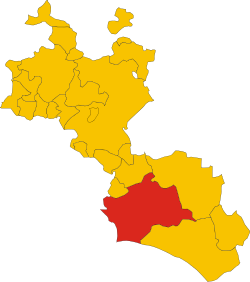Butera, Sicily
| Butera | ||
|---|---|---|
| Comune | ||
| District of Butera | ||
 |
||
|
||
 Butera in the Province of Caltanissetta |
||
| Location of Butera in Italy | ||
| Coordinates: 37°11′N 14°11′E / 37.183°N 14.183°E | ||
| Country | Italy | |
| Region | Sicily | |
| Province | Caltanissetta (CL) | |
| Frazioni | Butera Scalo, Falconara, Marina di Butera, Piano della Fiera, Tenutella | |
| Government | ||
| • Mayor | Luigi Casisi | |
| Area | ||
| • Total | 295 km2 (114 sq mi) | |
| Elevation | 402 m (1,319 ft) | |
| Population (31 December 2014) | ||
| • Total | 4,821 | |
| • Density | 16/km2 (42/sq mi) | |
| Demonym(s) | Buteresi | |
| Time zone | CET (UTC+1) | |
| • Summer (DST) | CEST (UTC+2) | |
| Postal code | 93011 | |
| Dialing code | 0934 | |
| Patron saint | St. Roch | |
| Saint day | August 16 | |
| Website | Official website | |
Butera (Sicilian: Vutera) is an Italian town and a comune in the province of Caltanissetta, in the southern part of the island of Sicily. It is bounded by the comuni of Gela, Licata, Mazzarino, Ravanusa and Riesi. It has a population of 4,821 (2014) and is 49 km (30 mi) from Caltanissetta, the province's capital.
The etymology of the name Butera is debated.
One hypothesis is that the name is of Arabic origin. Butera was called Butirah by the Arabs, which means "steep place". The Arabic demonym al-Buthayri was used to refer to a person from Butera (Arabic: Buthayr).
Another would suggest that the name "Butera" is of Greek origin, and several contemporary scholars tend to reject the Arabic theory of Butera's etymology. This is upheld by Giovan Battista Pellegrini, who claims that "The Arabic form for Butera, always with the interdental, should be an indication of a Greek etymon with / d / (the etymological assumptions from Arabic do not satisfy)". Upholders of a Greek origin for the Butera have suggested that the word may come from bothèr (shepherd),boutherès (country which permits for summer pasture),boutyros (butter merchant) or bouteron (butter). B. Pace himself has asserted that the term, aside from boutherès, may derive also from the Graeco-Byzantine word patela (plain), which refers Butera’s location.
In the area of "Piano fiera" (a new neighborhood built below the old town) where a prehistoric necropolis still stands, is a construction called "dolmen cysts" made of stone slabs assembled in cubiform manner (a style found also throughout Sardinia). Used also in the Greek period, the monument is associated with cult practices, both Hellenic and indigenous, and characterised by the positioning of human remains inside urns (Gk: enchytrismόs) which, in turn, were placed inside these small chambers.
...
Wikipedia


